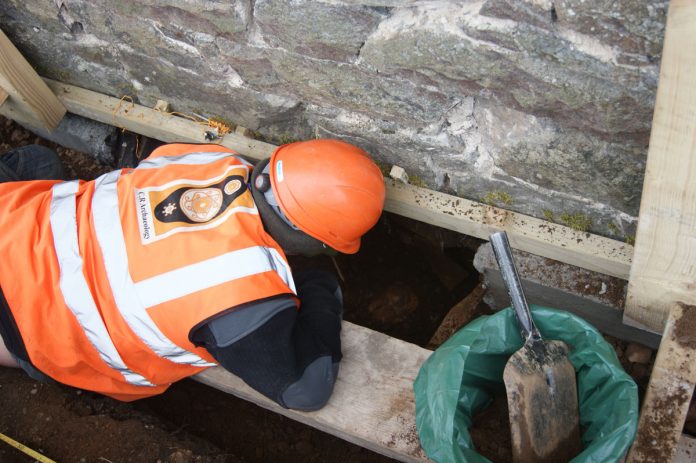In 1977 this church was converted for use as a museum, focusing on the maritime heritage of Nefyn and the surrounding area. Unfortunately the museum was forced to close in 2000 but seven years later the local community came together to secure new funding to repair, modernise and re-open the centre. (www.llyn-maritime-museum.co.uk)
In the winter of 2013 these improvement works began and the accompanying excavations carried out by C.R Archaeology uncovered some exciting remains from Nefyn’s Medieval and even Prehistoric past.
A phased approach
The project was carried out in several stages with archaeological discoveries made throughout the scheme of works. The first major discovery came to light during the excavation of foundations for the storage shed in the churchyard. Beneath the planned shed foundations the remains of large stone built wall with internal plasterwork was uncovered; over a meter wide and not recorded on the early maps of the area it is believed this wall is part of the medieval monastic settlement which is known to have developed around the early church. A single rounded stone found in the subsoil showed the tell-tale signs of a hammerstone or grinder and is evidence of prehistoric activity in the area.
A remarkable find
The underpinning of the church itself yielded the most exciting archaeological finds when monitoring works on the east side of the church. A series of large flat stones were found at a depth of a meter below the current church foundation level. Archaeologist Matt Jones of C.R Archaeology immediately recognised that these were more than likely the capping of a stone cist grave (a stone lined burial).
This type of tomb is most commonly dated to the early medieval period and would therefore have been contemporary with the founding of the church. What was most exciting was when the stone cover was recorded and lifted it was found that there was a surviving skeleton within the grave – a rarity in Wales due to acidic soil conditions.
These remains have provided us with a rare opportunity to obtain secure dating evidence for this type of grave and to gain further knowledge about the person buried including their sex, height, age, diet and the location where this person may have grown up.
A story from her bones
The remains were sent to an osteologist for further study and it was revealed that the Nefyn skeleton was that of a woman in her 60’s and that she was in relatively good health before she died, although the bones did exhibit some signs of arthritis.
This type of grave is generally believed to be early Medieval in date, however, when this individual was radiocarbon dated she was found to have been buried sometime between 1180 – 1250 A.D making the Nefyn lady the latest known burial of this type in Wales and one of only a small number of a similar date in the UK.
A turbulent time
She would have lived through some very turbulent times in Welsh history and could have lived through the rise to power of Llywelyn ap Iorwerth, (better known in English speaking areas as Llywelyn the Great), as he consolidated much of Wales under his control. She may have also been alive when the famous Medieval chronicler Gerald of Wales stayed at Nefyn in 1188 as part of a campaign to raise support for the third crusade.
Further studies of the skeleton are currently being conducted and it is hoped that we will soon be able to determine where she grew up by examining the Strontium and Nitrogen isotopes found within dental enamel. This is of particular importance given that Nefyn is on the pilgrimage route to Bardsey Island and she may have been either a local resident or a pilgrim travelling to worship but dying near this sacred site. A study of the type of stone used in the cist construction will also be conducted to determine whether or not the stone is from a local source.



